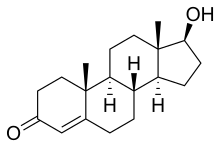Our website is made possible by displaying online advertisements to our visitors.
Please consider supporting us by disabling your ad blocker.
Hyperandrogenism
| Hyperandrogenism | |
|---|---|
| Other names | Androgen excess |
 | |
| High levels of testosterone cause hyperandrogenism | |
| Pronunciation | |
| Specialty | Endocrinology |
| Symptoms | Acne, hair loss on scalp, increased body or facial hair, hypertension, infrequent or absent menstruation[1][2] |
| Causes | Polycystic ovary syndrome, adrenal hyperplasia, Cushing's disease, cancer[1][3] |
| Diagnostic method | Blood tests, ultrasound[1][4] |
| Treatment | Birth control pills, cyproterone acetate, spironolactone, antiandrogen[1] |
| Frequency | 5% in reproductive age women[2] |
Hyperandrogenism is a medical condition characterized by high levels of androgens. It is more common in women than men.[4] Symptoms of hyperandrogenism may include acne, seborrhea, hair loss on the scalp, increased body or facial hair, and infrequent or absent menstruation.[1][2] Complications may include high blood cholesterol and diabetes.[4] It occurs in approximately 5% of women of reproductive age.[2]
Polycystic ovary syndrome accounts for about 70% of hyperandrogenism cases.[1] Other causes include Congenital adrenal hyperplasia, insulin resistance, hyperprolactinemia, Cushing's disease, certain types of cancers, and certain medications.[4][1][3] Diagnosis often involves blood tests for testosterone, 17-hydroxyprogesterone, and prolactin, as well as a pelvic ultrasound.[1][4]
Treatment depends on the underlying cause.[4] Symptoms of hyperandrogenism can be treated with birth control pills or antiandrogens, such as cyproterone acetate or spironolactone.[1][4] Other measures may include hair removal techniques.[3]
The earliest known description of the condition is attributed to Hippocrates.[5][6]
In 2011, the International Association of Athletics Federations (now World Athletics) and IOC (International Olympic Committee)[7] released statements restricting the eligibility of female athletes with high testosterone, whether through hyperandrogenism or as a result of a difference in sex development (DSD). These regulations were referred to by both bodies as hyperandrogenism regulations and have led to athletes with DSDs being described as having hyperandrogenism.[8][9] They were revised in 2019 to focus more specifically on DSDs.[10]
- ^ a b c d e f g h i Peigné M, Villers-Capelle A, Robin G, Dewailly D (2013). "[Hyperandrogenism in women]". Presse Médicale. 42 (11): 1487–99. doi:10.1016/j.lpm.2013.07.016. PMID 24184282. S2CID 28921380.
- ^ a b c d Curtis M, Antoniewicz L, Linares ST (2014). Glass' Office Gynecology. Lippincott Williams & Wilkins. p. 39. ISBN 978-1-60831-820-9. Archived from the original on 24 February 2024. Retrieved 30 August 2020.
- ^ a b c Catteau-Jonard S, Cortet-Rudelli C, Richard-Proust C, Dewailly D (2012). "Hyperandrogenism in adolescent girls". Endocrine Development. 22: 181–193. doi:10.1159/000326688. ISBN 978-3-8055-9336-6. PMID 22846529.
- ^ a b c d e f g Carlson KJ, Eisenstat SA (2004). The New Harvard Guide to Women's Health. Harvard University Press. p. 286. ISBN 978-0-674-01282-0.
- ^ Banker M (2019). Nova IVI Textbook of Infertility & Assisted Reproductive Technology. JP Medical Ltd. p. 237. ISBN 978-9-3889-5884-4. Archived from the original on 24 February 2024. Retrieved 30 August 2020.
- ^ Pathobiology of Human Disease: A Dynamic Encyclopedia of Disease Mechanisms. Elsevier. 2014. p. 1385. ISBN 978-0-12-386457-4. Archived from the original on 24 February 2024. Retrieved 30 August 2020.
- ^ "IOC addresses eligibility of female athletes with hyperandrogenism". International Olympic Committee. 2011. Archived from the original on 25 October 2020. Retrieved 20 September 2020.
- ^ Washington Post Staff (2019). "What are the issues behind the Court of Arbitration for Sport ruling in Caster Semenya case?". The Washington Post. Archived from the original on 25 October 2020. Retrieved 20 September 2020.
- ^ Abraham R (2019). "What's with the gender inequality? Dutee Chand talks about the tests female athletes face before competing". The Economic Times. Bennett, Coleman & Co. Ltd. Archived from the original on 15 December 2020. Retrieved 20 September 2020.
- ^ Cite error: The named reference
:14was invoked but never defined (see the help page).
Previous Page Next Page


